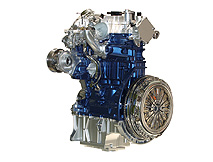News Center
News CenterAll-New 1.0-litre Ford EcoBoost Engine Further Extends Advanced EcoBoost Technology in China
 The all-new 1.0-litre Ford EcoBoost engine.
The all-new 1.0-litre Ford EcoBoost engine. - The all-new engine will debut in China in the all-new Ford EcoSport – offering the performance of a conventional 1.6-litre engine with less than 140g/km CO2 emissions
- The fuel-efficient three-cylinder broadens the range of EcoBoost™ engines in China – the new Mondeo is currently available with a 2.0-litre EcoBoost four-cylinder while the all-new Ford Kuga will feature 1.6-litre and 2.0-litre EcoBoost engines
- This newest and smallest member of the global family of EcoBoost engines features advanced turbo-charging technology, improved twin independent variable camshaft timing and intelligent ancillaries to deliver performance that belies its small size
BEIJING, April 22, 2012 – Ford is expanding its advanced EcoBoost™ powertrain technology in China with the addition of its newest and smallest-ever EcoBoost engine. With only three cylinders and 1.0 litre of displacement, the latest EcoBoost engine will provide fuel-efficient power for the all-new Ford EcoSport.
Despite its smaller capacity and proportions, the engine delivers power and performance that will rival a traditional 1.6-litre petrol engine while emitting less than 140g/km CO2. It will have 88 kW of power and 170 Nm of torque. Mated to a five-speed manual transmission, it will give the Ford EcoSport a footprint that is small enough for urban driving yet robust enough for a trip out of the city.
The 1.0-litre EcoBoost uses turbocharging and direct fuel injection to extract impressive levels of power and fuel efficiency from its three-cylinder engine block, which is so small that it can fit on a sheet of A4 paper. This combination of power and low CO2 emissions is unmatched by competitors in its segment.
Ultimately, this all-new engine will be made available in Ford models in Asia, Europe, North America and other regions.
The 1.0-litre three-cylinder is the latest addition to Ford’s family of EcoBoost engines in China. The new Mondeo currently features a 2.0-litre EcoBoost four-cylinder while the all-new Ford Kuga will launch with a 1.6-litre EcoBoost engine as well as the 2.0-litre EcoBoost engine.
Downsized EcoBoost engines feature turbocharging, direct injection and other technologies and replace larger engines with no loss of performance and with lower fuel consumption.
“China was one of the first markets in Asia to enjoy the progressive EcoBoost technology,” said Kumar Galhotra, vice president, Product Development, Ford Asia Pacific and Africa. “The introduction of the small-but-potent 1.0-litre EcoBoost engine demonstrates Ford’s continued commitment to bring the latest powertrains that deliver superior fuel economy and reduced carbon dioxide emissions to China.”
Compact and responsive
Developed at Ford’s Dunton Technical Centre in the U.K., the 1.0-litre EcoBoost engine features a new compact, high performance turbocharger design. The extremely fast response of the turbocharger and its ability to reach nearly 250,000 rpm results in virtually no turbo lag and peak torque of 170 Nm from 1,300-4,500 rpm. This high torque supports a fuel-efficient driving style and delivers a good performance feel and diesel-like torque experience.
The all-new EcoBoost engine also features an exhaust manifold cast into the cylinder head, which lowers the temperature of the exhaust gases and in turn enables the engine to run with the optimum fuel-to-air ratio across a wider rev band.
An advanced “split cooling” system reduces fuel consumption by warming the engine more quickly and – unique to the 1.0 engine –cast iron has been selected for the block, reducing the amount of energy needed for warm-up by up to 50 per cent compared with aluminium.
Intelligent ancillaries such as a variable air-conditioning compressor and oil pump also reduce demand on the engine – improving economy and emissions – while special coatings for engine components and intricate development of engine geometry result in minimal frictional losses.
Like its larger-capacity siblings, the 1.0-litre EcoBoost engine will use twin independent variable camshaft timing (Ti-VCT) to further improve performance and economy. Ford has also employed an all-new camshaft actuator to speed up response times without sacrificing durability.
“The 1.0-litre EcoBoost delivers great low-speed responsiveness, power, torque and smoothness,” said Galhotra. “To produce an engine with such impressive performance and fuel economy clearly reflects our commitment to be class-leading in fuel economy around the world."
Smooth and refined
In the all-new 1.0-litre Ford EcoBoost engine, the emphasis in development has been on delivering both smooth and refined performance.
Engine refinement is improved thanks to an innovative design that immerses the two main engine drive belts in oil – resulting in quieter and more efficient running but with the durability of a chain. Careful attention has also been paid to mitigating the natural vibrations of the three-cylinder design.
Rather than employ the traditional method of adding energy-draining balancer shafts, Ford engineers have deliberately “unbalanced” the flywheel and pulley to offset the engine configuration. Ford believes these innovations combined with optimised engine mounts will deliver a truly refined performance feel perfected during 720,000 kilometres of tests – including 360,000 kilometres of durability trials and 10,000 kilometres of environmental testing.
“Fitted with a long list of innovative technologies, the 1.0-litre EcoBoost is one of the most technically advanced and efficient engines Ford has ever designed and produced,” said Galhotra.
“This new engine demonstrates Ford’s laser focus on improving fuel economy without compromising performance. It will be an engine that not only surprises and delights our customers but also offers them great value in the lower cost of ownership.”
Related
-
Ford Unveils Two Cutting Edge Mobile Apps at Mobile Asia Expo; Shares Vision for Further Mobile Integration
-
Ford’s Stunning Cloud-Connected Evos Concept Car To Make Asia Debut At Computex 2012
-
Ford To Introduce SYNC To Taiwan In New Ford Focus
-
Ford Announces SYNC AppLink Coming to Asia, Giving Customers Voice Control of Smart Phone Apps








Connect With Ford
Ford Motor Company on Facebook
Ford Motor Company on YouTube
Follow @Ford on Twitter
Ford Motor Company on Flickr